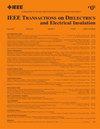Electric Field Mitigation in (U)WBG Power Module Using Nonlinear Field-Dependent Conductivity Layer and Protruding Substrate Under High-Frequency, High-Slew-Rate Square Wave Voltages
IF 3.1
3区 工程技术
Q2 ENGINEERING, ELECTRICAL & ELECTRONIC
IEEE Transactions on Dielectrics and Electrical Insulation
Pub Date : 2025-06-04
DOI:10.1109/TDEI.2025.3576326
引用次数: 0
Abstract
Incorporating nonlinear resistive field grading materials (FGMs) onto metal-brazed substrates has been widely investigated as an efficient electric field reduction strategy at triple points (TPs) within ultrawide bandgap [(U)WBG] power modules. However, most investigations have been carried out using either dc or sinusoidal ac voltages despite actual (U)WBG power modules operating with high-frequency square voltages featuring high-slew rate (采用非线性场相关电导率层和凸出基板的(U)WBG功率模块在高频、高速率方波电压下的电场抑制
将非线性电阻场分级材料(fgm)结合到金属钎焊衬底上,作为超宽带隙[(U)WBG]功率模块中三相点(TPs)的有效电场减小策略,已经得到了广泛的研究。然而,大多数研究都是使用直流或正弦交流电压进行的,尽管实际的(U)WBG功率模块工作在具有高压转率(${\textit {dv}}/ {\textit {dt}}}$)的高频方电压下。因此,本研究引入了场相关电导率(FDC)层来分析高频、高速率方电压下的电场衰减。使用COMSOL Multiphysics,对涂覆和未涂覆的结构进行建模,以评估电场减少。当采用非线性FDC涂层时,研究结果表明,即使在快速上升时间和高频率的方形电压下,场应力也显着降低。然而,仅仅依靠非线性FDC层可能无法充分解决电场问题,特别是考虑到金属化层上的突起和层覆盖面积的减少。为了应对这一挑战,金属端部的突出物被整合到突出的基板结构中。然后在整个结构上涂上一层非线性FDC层。突出的衬底和非线性FDC层的共同作用有效地减小了电场。然而,当上升时间缩短到75 ns,频率提高到500 kHz时,TPs周围的电场应力超过了绝缘的承受强度。这一发现强调了进一步研究替代策略的必要性,因为在(U)WBG功率模块的实际工作条件下,普遍的策略无法有效地缓解电场。
本文章由计算机程序翻译,如有差异,请以英文原文为准。
求助全文
约1分钟内获得全文
求助全文
来源期刊
CiteScore
6.00
自引率
22.60%
发文量
309
审稿时长
5.2 months
期刊介绍:
Topics that are concerned with dielectric phenomena and measurements, with development and characterization of gaseous, vacuum, liquid and solid electrical insulating materials and systems; and with utilization of these materials in circuits and systems under condition of use.

 求助内容:
求助内容: 应助结果提醒方式:
应助结果提醒方式:


